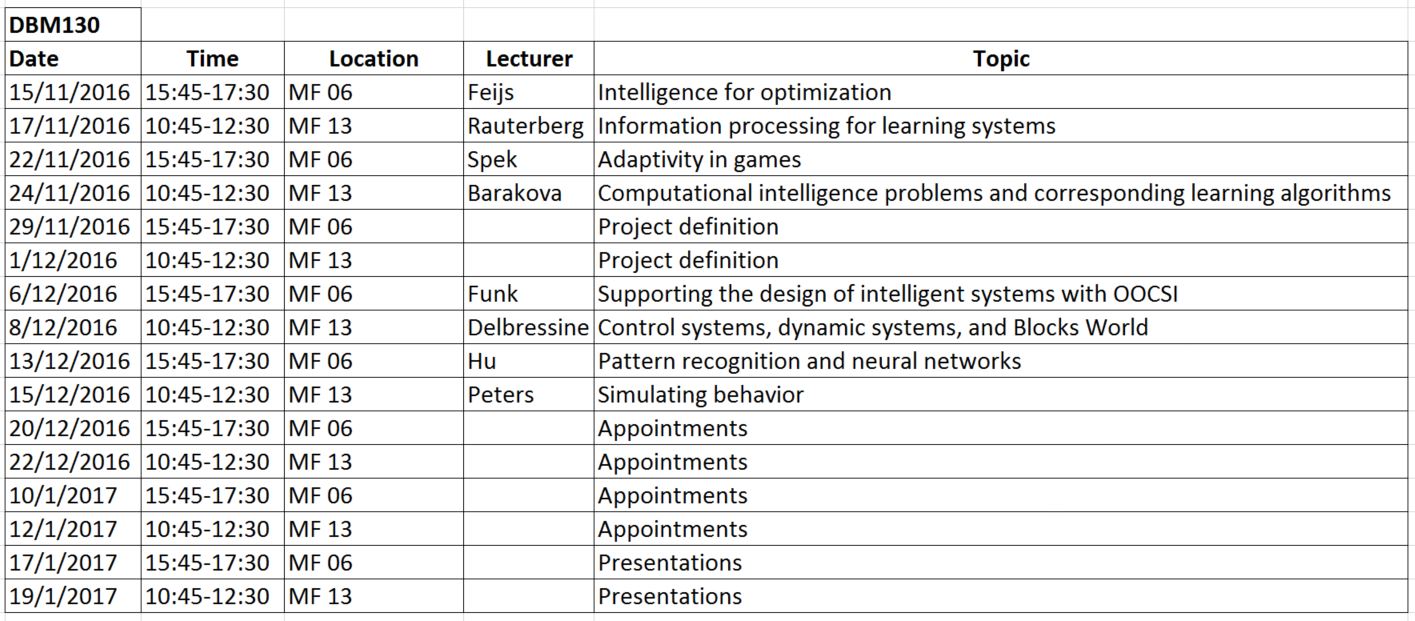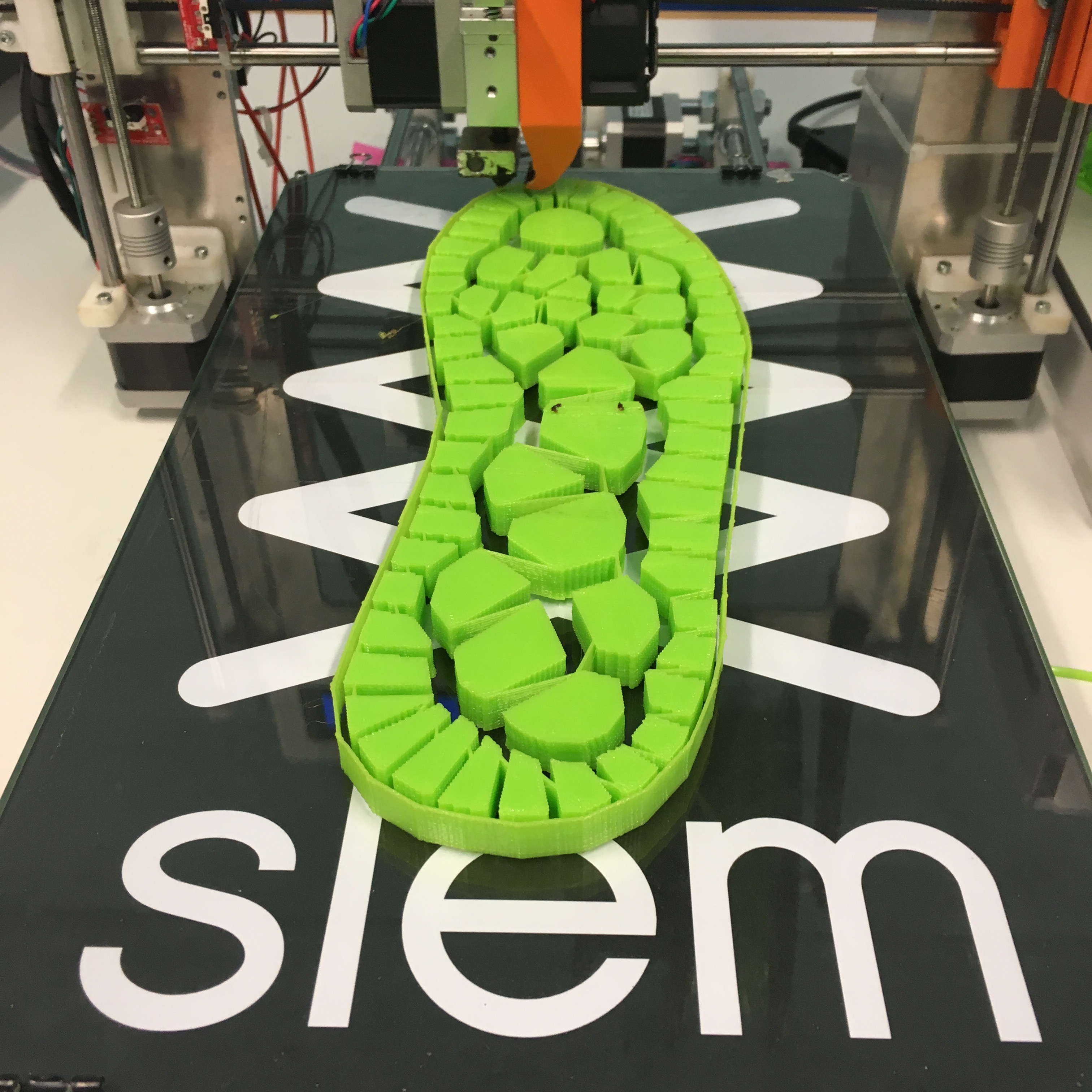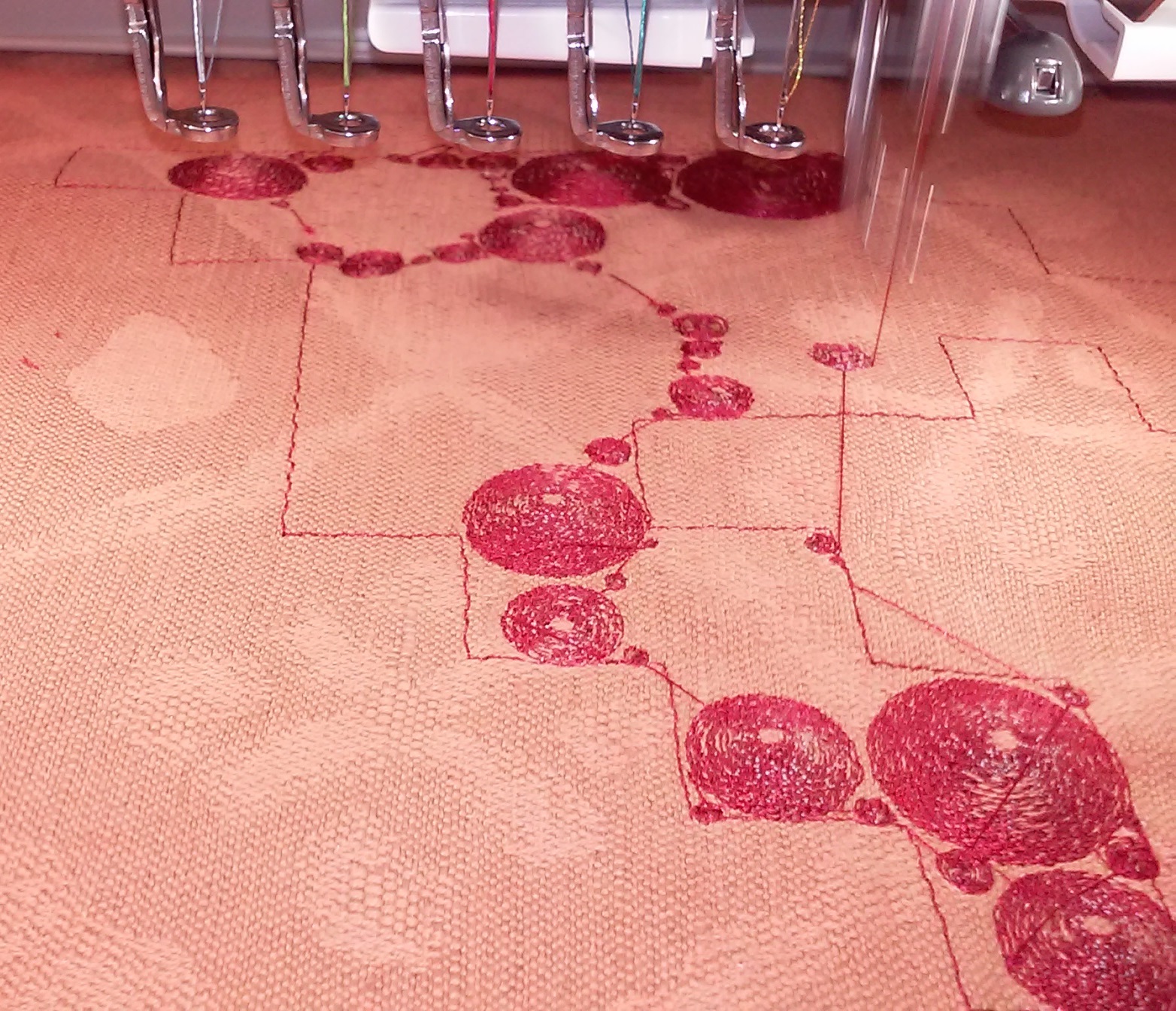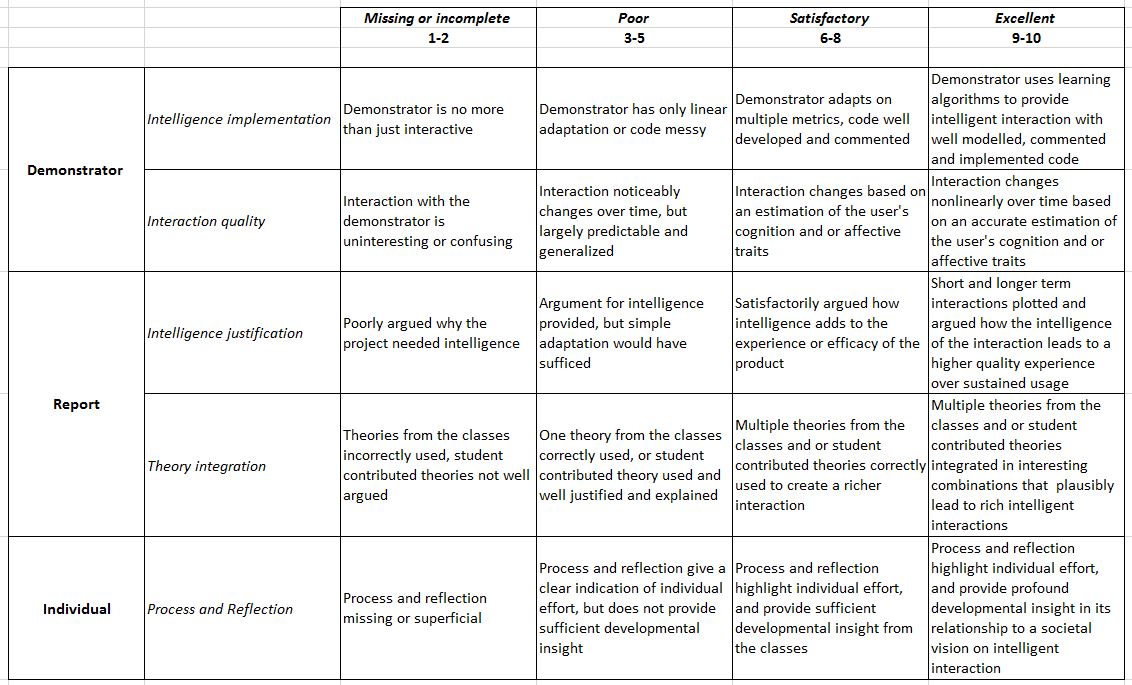|
Size: 57
Comment:
|
Size: 3214
Comment:
|
| Deletions are marked like this. | Additions are marked like this. |
| Line 1: | Line 1: |
| Describe DesigningIntelligenceInInteraction201609 here. | = DBM130 - Designing Intelligence in Interaction - Q2 2016 = <<TableOfContents>> == Assignment resources == * The assignment resources are mentioned in the AssignmentDescription == Schedule == {{attachment:schedule.jpg||width=800}} == Lecture and workshop materials and instructions == === Lecture 1: Intelligence for optimization - Loe Feijs === Intelligence for optimization. There exists algorithms for solving a class of problems called "combinatorial optimization". Typical examples are finding the shortest path in a network (packet routing), finding a tour along cities (delivery service) or finding an optimal path along graph edges (3D printing). Loe Feijs will illustrate the famous traveling salesman problem showing an interactive and intelligent G-code generator project for shoe soles (joint work with Troy Nachtigall). Another illustration is the optimal computerized embroidery path for the Pied de Pulse project (joint work with Marina Toeters). {{attachment:sole.jpg||height=200}} {{attachment:pieddepulse.jpg||height=200}} References: Feijs, L.M.G. & Toeters, M.J. (2016). Pied de pulse: packing embroidered circles and coil actuators in pied de poule (houndstooth). In C. Sequin, D. McKenna, E. Torrence, R. Sarhangi, B. Torrence & K. Fenyvesi (Eds.), Proceedings of Bridges 2016: Mathematics, Music, Art, Architecture, Education, Culture, Jyväskylä, August 9-13, 2016 (pp. 415-418), http://archive.bridgesmathart.org/2016/bridges2016-415.html Feijs, L.M.G., Nachtigall, T., Tomico, O. Sole Maker: Towards Ultra-personalised Shoe Design Using Voronoi Diagrams and 3D Printing. Proceedings of SMI'2016 Fabrication and Sculpting Event (FASE), Reprinted in: Hyperseeing, Tthe Publication of the international Society of Arts, Mathematics and Architecture; SUMMER 2016, http://www.geometrysummit.org/proceedings/fase2016/papers/1.pdf * [[attachment:Lecture1.pdf|Lecture 1 slides]] === Lecture 2: Information processing for learning systems - Matthias Rauterberg === * [[attachment:Lecture2.pdf|Lecture 2 slides]] === Lecture 3: Pattern recognition and neural network - Jun Hu === * [[attachment:Lecture3.pdf|Lecture 3 slides]] === Lecture 4: Design of social scenarios - Emilia Barakova === * [[attachment:Lecture4.pdf|Lecture 4 slides]] === Lecture 5: Adaptivity in games - Erik van der Spek === * [[attachment:Lecture5.pdf|Lecture 5 slides]] === Lecture 6: Supporting the design of intelligent systems with OOCSI - Mathias Funk === * [[attachment:Lecture6.pdf|Lecture 6 slides]] === Lecture 7: Control systems, dynamic systems, and Blocks World - Frank Delbressine === * [[attachment:Lecture7.pdf|Lecture 7 slides]] === Lecture 8: Simulating behavior - Peter Peters === * [[attachment:Lecture8.pdf|Lecture 8 slides]] == Deliverables == * TBD == Rubrics == {{attachment:rubrics.jpg}} <<Anchor(installNetLogo)>> == Installing NetLogo == 1. Follow the instructions on the [[https://ccl.northwestern.edu/netlogo/|NetLogo website]] to download and install NetLogo 1. Check out the description [[https://ccl.northwestern.edu/netlogo/docs/|here]] and the [[https://ccl.northwestern.edu/netlogo/videos.shtml|videos]] |
DBM130 - Designing Intelligence in Interaction - Q2 2016
Contents
-
DBM130 - Designing Intelligence in Interaction - Q2 2016
- Assignment resources
- Schedule
-
Lecture and workshop materials and instructions
- Lecture 1: Intelligence for optimization - Loe Feijs
- Lecture 2: Information processing for learning systems - Matthias Rauterberg
- Lecture 3: Pattern recognition and neural network - Jun Hu
- Lecture 4: Design of social scenarios - Emilia Barakova
- Lecture 5: Adaptivity in games - Erik van der Spek
- Lecture 6: Supporting the design of intelligent systems with OOCSI - Mathias Funk
- Lecture 7: Control systems, dynamic systems, and Blocks World - Frank Delbressine
- Lecture 8: Simulating behavior - Peter Peters
- Deliverables
- Rubrics
- Installing NetLogo
Assignment resources
The assignment resources are mentioned in the AssignmentDescription
Schedule
Lecture and workshop materials and instructions
Lecture 1: Intelligence for optimization - Loe Feijs
Intelligence for optimization. There exists algorithms for solving a class of problems called "combinatorial optimization". Typical examples are finding the shortest path in a network (packet routing), finding a tour along cities (delivery service) or finding an optimal path along graph edges (3D printing).
Loe Feijs will illustrate the famous traveling salesman problem showing an interactive and intelligent G-code generator project for shoe soles (joint work with Troy Nachtigall). Another illustration is the optimal computerized embroidery path for the Pied de Pulse project (joint work with Marina Toeters).
References:
Feijs, L.M.G. & Toeters, M.J. (2016). Pied de pulse: packing embroidered circles and coil actuators in pied de poule (houndstooth). In C. Sequin, D. McKenna, E. Torrence, R. Sarhangi, B. Torrence & K. Fenyvesi (Eds.), Proceedings of Bridges 2016: Mathematics, Music, Art, Architecture, Education, Culture, Jyväskylä, August 9-13, 2016 (pp. 415-418), http://archive.bridgesmathart.org/2016/bridges2016-415.html
Feijs, L.M.G., Nachtigall, T., Tomico, O. Sole Maker: Towards Ultra-personalised Shoe Design Using Voronoi Diagrams and 3D Printing. Proceedings of SMI'2016 Fabrication and Sculpting Event (FASE), Reprinted in: Hyperseeing, Tthe Publication of the international Society of Arts, Mathematics and Architecture; SUMMER 2016, http://www.geometrysummit.org/proceedings/fase2016/papers/1.pdf
Lecture 2: Information processing for learning systems - Matthias Rauterberg
Lecture 3: Pattern recognition and neural network - Jun Hu
Lecture 4: Design of social scenarios - Emilia Barakova
Lecture 5: Adaptivity in games - Erik van der Spek
Lecture 6: Supporting the design of intelligent systems with OOCSI - Mathias Funk
Lecture 7: Control systems, dynamic systems, and Blocks World - Frank Delbressine
Lecture 8: Simulating behavior - Peter Peters
Deliverables
- TBD
Rubrics
Installing NetLogo
Follow the instructions on the NetLogo website to download and install NetLogo




